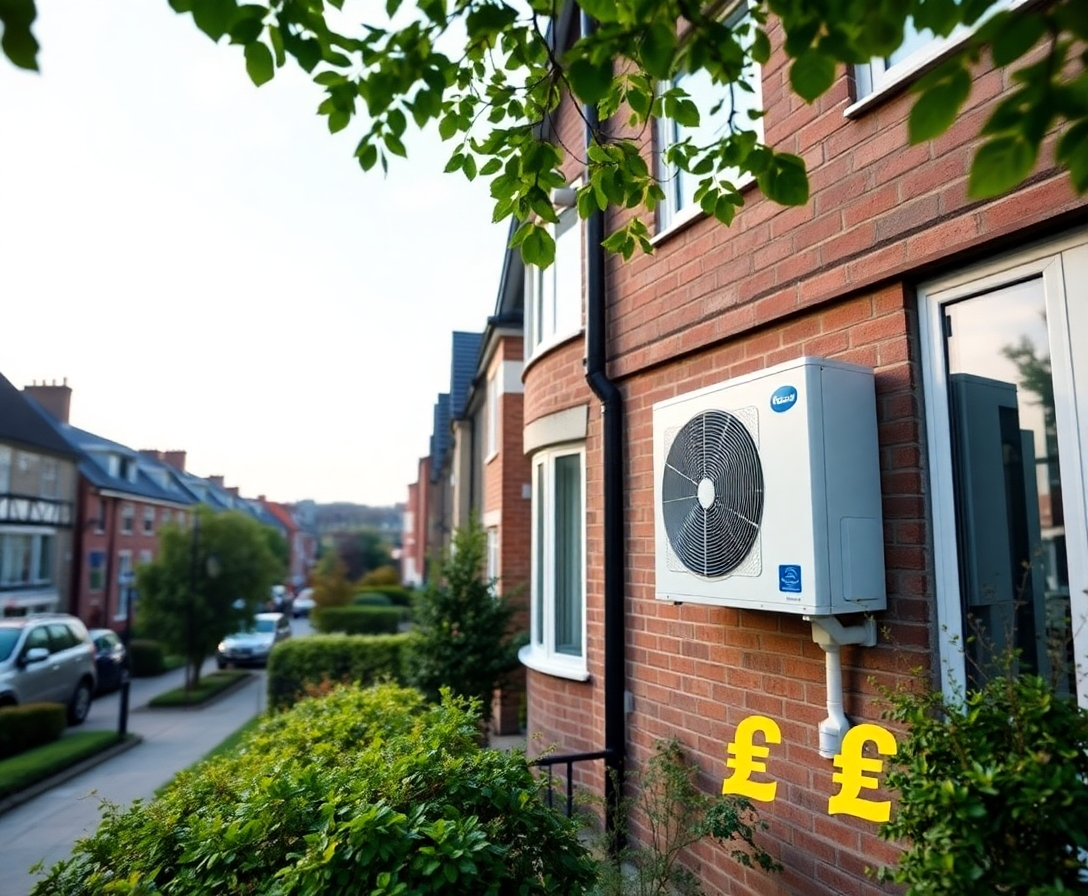When it comes to upgrading your home’s heating system, more and more British households are turning to air-source heat pumps (ASHPs). These innovative systems harness the ambient warmth in the outside air to provide energy-efficient heating and hot water, even in colder weather. Whether you’re worried about rising fuel costs, concerned about reducing your carbon footprint, or simply looking for a long-term investment in your property, air-source heat pumps could offer a practical solution. In this in-depth guide, we’ll explore how ASHPs work, how they can help you save money, and the grants and incentives available to support your switch to low-carbon heating.
1. What Are Air Source Heat Pumps?
An air source heat pump is a renewable heating system that transfers heat from the air outside your home to the interior. Even when the temperature outdoors feels chilly, there is still heat energy in the air. ASHPs capture and concentrate this heat using a process similar to refrigeration in reverse. The heat is then used to warm your home via radiators, underfloor heating, or even warm air convectors, and can also provide hot water for your taps and showers.
Key Components
- Outdoor Unit: The unit sits outside your home and contains a fan that draws in external air.
- Heat Exchanger: Within the unit, the air passes over a network of coils containing a refrigerant fluid that absorbs the heat.
- Compressor: The compressor increases the temperature of the refrigerant by putting it under pressure, concentrating the heat.
- Indoor Distribution System: Warmth is distributed through a wet central heating circuit (radiators or underfloor heating) or a hot water storage tank.
2. How Do They Work?
The process an air source heat pump uses is generally known as a vapour-compression cycle:
- Evaporation: The refrigerant in the outdoor unit absorbs heat from the air, causing it to evaporate.
- Compression: The electric compressor raises the pressure of the vapour, significantly increasing its temperature.
- Condensation: The now-hot refrigerant vapour passes through a heat exchanger, transferring heat into your home’s heating and hot water systems. As it loses heat, the refrigerant returns to a liquid state.
- Expansion: The refrigerant flows through an expansion valve and cools down, ready to absorb more heat from the outside air, repeating the cycle.
This method of extracting and “pumping” heat from the air means that, under typical conditions, an air source heat pump can produce up to three times as much heat energy as the electrical energy it consumes. This ratio is called the Coefficient of Performance (COP). A COP of 3:1, for instance, indicates that for every 1 kilowatt (kW) of electricity used by the heat pump, around 3 kW of heat is delivered to the home—making it exceptionally efficient compared to traditional gas or oil boilers.
3. Benefits of Air Source Heat Pumps
a) Lower Running Costs
Despite the UK’s often cool and damp climate, air source heat pumps work effectively to deliver reliable heating and hot water. Their high efficiency can result in noticeably lower monthly bills, especially if you’re switching from expensive or carbon-intensive fuels such as oil, LPG, or electricity-based direct heating. While prices will vary depending on your energy tariff and how your home is insulated, many homeowners see a tangible reduction in their overall heating costs once they switch.
b) Reduced Carbon Footprint
Air source heat pumps use renewable energy from the air and draw on electricity for power. If you sign up for a green electricity tariff, your heat pump could essentially become a low-carbon—or even zero-carbon—heating source. This reduction in your home’s carbon emissions not only helps meet national climate targets but also contributes to a healthier environment for future generations.
c) Longevity and Low Maintenance
High-quality heat pumps typically have a lifespan of 15 to 20 years or more, surpassing many conventional boilers. Apart from periodic checks by a professional installer, ASHPs generally require minimal upkeep—there’s no need to store fuel on-site, and there are fewer moving parts compared to a combustion-based system.
d) Versatile Installation Options
Most air source heat pumps can be installed in homes with or without gas mains access, making them suitable for rural properties as well as urban dwellings. Although these systems perform optimally in well-insulated homes, insulation improvements can be relatively straightforward. Upgrading loft or cavity wall insulation before installing a heat pump is often recommended to maximise efficiency and comfort.
4. Potential Challenges
It’s worth noting that while air-source heat pumps bring many advantages, they may not be ideal for every property. To get the most out of an ASHP, you typically need:
- Sufficient Space: You’ll need an outdoor space with room for the external unit, which needs a good flow of air.
- Well-Insulated Property: Heat pumps produce lower temperature heat than traditional boilers, so proper insulation helps maintain comfortable indoor temperatures efficiently.
- Radiator Upgrade: Some homes with older radiators or undersized heating systems may need upgrades to optimise heat distribution.
These considerations might raise initial costs, but they typically pay off over time in terms of lower energy bills and improved home efficiency.
5. How ASHPs Save You Money
a) Greater Efficiency
Because ASHPs operate at a higher efficiency than most conventional boilers, your primary expenses are tied to the electricity they consume. If your home’s insulation is up to par and you have the right tariff, you can achieve substantial savings over time, especially if your previous heating source was pricey or inefficient.
b) Potential for Tariff Optimisation
With modern technology, many energy suppliers offer time-of-use tariffs that let you pay less for electricity during off-peak hours. By scheduling your heat pump to run mainly during cheaper rate periods, you can reduce running costs even further.
c) Reduced Maintenance Costs
Air source heat pumps typically have fewer components that can fail compared to gas boilers, which require annual servicing to comply with safety regulations. While you should still have your ASHP inspected periodically, the system’s simpler design may lead to lower ongoing maintenance costs.
6. Grants and Incentives in the UK
One of the biggest considerations for any major home improvement is the initial investment. Air source heat pumps can be more expensive to install than a traditional boiler replacement. However, various grants and incentive schemes are designed to offset part of these upfront costs:
a) Boiler Upgrade Scheme
The Boiler Upgrade Scheme (BUS) replaces the former Domestic Renewable Heat Incentive (RHI) and offers up to £5,000 towards the cost of installing an air source heat pump in domestic and small non-domestic properties in England and Wales. This scheme supports households looking to transition away from fossil fuel heating systems, effectively reducing the time it takes to recoup their investment.
For more information on eligibility and application processes, visit the official GOV.UK Boiler Upgrade Scheme page.
b) Local Authority Schemes
Depending on where you live, local councils sometimes offer their own energy efficiency grants or partner with organisations to help homeowners with green home improvements. These might include subsidised insulation, vouchers for energy-saving measures, or discounted installation of low-carbon heating systems.
c) Energy Company Obligation (ECO)
Through the ECO scheme, larger energy suppliers are obligated to help lower-income households or those with harder-to-heat homes to install energy efficiency measures, which can sometimes include heating systems. Eligibility criteria vary, so check with your energy supplier to see if you qualify.
7. Installation Considerations
a) Choosing an Installer
When choosing an installer, look for MCS (Microgeneration Certification Scheme) accreditation and membership in a recognised trade association (e.g., the Renewable Energy Consumer Code, or RECC). This helps ensure that the work is carried out to high standards and may be a requirement for certain grants or incentives.
b) Planning Permission
In most cases, installing an air source heat pump is considered a permitted development for homeowners in England and Scotland, meaning you don’t usually need full planning permission, provided certain conditions are met. However, if you live in a listed building or conservation area, or if you’re not sure about local restrictions, it’s always best to check with your local planning authority.
c) Pairing with Other Green Technologies
To maximise the benefits of your ASHP, consider pairing it with solar panels or battery storage. Generating your renewable electricity to power your heat pump can enhance your overall energy savings and reduce your reliance on the grid.
8. Further Advice and Support
Switching to an air-source heat pump is a major decision, and it pays to do thorough research. Reputable sources of information include:
- Energy Saving Trust: Their comprehensive guidance on air source heat pumps outlines costs, benefits, and typical payback periods.
- Ofgem: The energy regulator’s website provides details on grants, regulations, and any updates to government schemes that may affect home energy improvements.
It may also be worth talking to neighbours, friends, or community groups who have already switched to an ASHP. First-hand experiences can often provide valuable insight into what to expect during installation, how to optimise your system for the best performance, and what level of savings you might realistically achieve.
9. Conclusion
Air source heat pumps are a forward-thinking solution for homeowners keen to reduce both their energy bills and carbon footprint. Although the initial outlay can be higher than a conventional boiler, the long-term savings on energy bills, combined with financial support from schemes such as the Boiler Upgrade Scheme, make them an increasingly attractive choice. With British winters growing more unpredictable and energy prices subject to change, investing in a stable, efficient system like an air source heat pump can bring peace of mind—and potentially boost your property’s value.
By making sure your home is well insulated, exploring additional improvements such as solar panels, and choosing a qualified installer, you’ll set yourself up for success. Before you commit, don’t forget to explore grants, speak to experts, and weigh up how quickly you could recoup your costs through lower energy bills. When done right, installing an air source heat pump can be a game-changer in creating a greener, more cost-effective home.
About Energy Rate Radar
At Energy Rate Radar, we’re committed to helping UK homeowners make smart choices about their energy use. Whether you’re curious about renewable heating technologies, interested in lowering your utility bills, or simply want up-to-date insights into the UK energy market, we’re here to guide you every step of the way.


